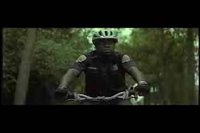 From time to time, I'll be excavating unedited versions of interviews that aren't otherwise available online. To that end, here's the first draft of my conversation with the Brothers Quay. Because I was unable to record our call, there aren't many direct or in-depth quotations, but I took as many notes as I possibly could. The finished edition appears in the 4/07 issue of Resonance, which ceased publication in 2/08.
From time to time, I'll be excavating unedited versions of interviews that aren't otherwise available online. To that end, here's the first draft of my conversation with the Brothers Quay. Because I was unable to record our call, there aren't many direct or in-depth quotations, but I took as many notes as I possibly could. The finished edition appears in the 4/07 issue of Resonance, which ceased publication in 2/08.***** ***** ***** ***** ***** ***** ***** ***** ***** *****
Welcome to a shadow world where plastic dolls walk, stuffed rab-
bits juggle, and dead opera singers return to life. That description
can only apply to the handiwork of filmmaking twins Stephen and Timothy Quay (born 1947), better known as the Brothers Quay.
Starting in January, a program of their short films will be traveling to select US cities. The British Film Institute has also produced a double-disc set, The Quay Brothers: The Short Films 1979-2003, which trumps Kino’s single-disc The Brothers Quay Collection: Ten Astonishing Short Films 1984-1993. Due in April from Zeitgeist, the new set includes 13 re-mastered films plus commentaries, an interview, and promotional spots.
Although many twins like to assert their unique personalities, that
doesn't seem to be the case with the Quays. Mention that their entries at the Internet Movie Database are identical, and they con-
firm that their filmographies are exactly the same. Frankly, they would prefer a single entry, suggesting, "If we write 10 letters, and
your friends write 10 letters, maybe we can get them to change that." (Over the line, it's impossible to tell the difference between the two friendly voices—if only telephones were stereophonic!)
Like Joseph Losey, Richard Lester, and Stanley Kubrick,
the Quays moved to England and never looked back. Born
in Norristown, PA, they left for London in 1969. The lure: The Royal College of Art. So, do they feel an affinity with their cin-
ematic predecessors? "Not really,” they answer, almost sad-
ly. "We're just not in the same league." (Au contraire, mes dears.)
What about fellow expatriate Terry Gilliam? "We know Terry,
but he we know him as a friend rather than a fan," they explain. That said, once Gilliam signed on to executive produce The Piano Tuner of Earthquakes (2005), in which Catherine Breillat favorite Amira Casar (Romance, Anatomy of Hell) plays the doomed opera
singer, financing fell into place. For that, they remain eternally grateful. After all, 10 years have passed since their full-length deb-
ut, the haunting Institute Benjamenta with future Borg Queen Al-
ice Krige, Mark Rylance (Angels & Insects, Intimacy), and Fass-binder fixture Gottfried John, who returns in The Piano Tuner. With the extensive in-cam-
With the extensive in-cam-
era effects that populate their
pictures, amongst other fac-
tors, their features tend to
take longer to complete than those of fellow innerspace explorers Michel Gondry and
Guy Maddin. (The latter, in
his Piano Tuner review for Film Comment, proclaims it “absolutely entrancing!!!")
The Quays, however, are in no rush to start in on a third,
though it isn't out of the question. "We have an idea for some-
thing," they hint. For now, they’re focusing on two installations. "One is in a castle in the north of England, outside of Newcastle." Their task is to fill one of the 25 rooms as they see fit, "to respond to
the space itself." The second is for a Leeds opera celebrating
the 400th anniversary of Claudio Monteverdi‘s L’orfeo.
Film, however, is always on their minds, and the brothers men-
tion that they're working on a television project, an adaptation
of Bruno Schultz's Sanatorium under the Sign of the Hourglass (1937). Throughout their career, the Quays have often turned
to the Polish writer, along with Franz Kafka, Lewis Carroll, and Robert Walser, while artistic inspirations include Max Ernst, Francis Bacon, Hieronymus Bosch, and M.C. Escher. For The Street of Crocodiles (1986), their most acclaimed short, they adapted Schultz, and for the B&W Institute Benjamenta (1995), they took on Walser's 1909 novel Jakob von Gunten.
In filmmaking terms, the name most often associated with the Brothers Quay is that of Jan Švankmajer, whose latest prov-
ocation is the gleefully wacked Lunacy (2006). Do they remain
in contact with the Czechoslovakian master? "He's a man we made
a documentary about [1984's The Cabinet of Jan Švankmajer], and we occasionally meet at film festivals and the like, which is always a pleasure, but we're not in touch. He's just a giant. We
see him more as a teacher and a model." If they had to name one
influence, they insist, it would actually be Polish surrealist-turned-softcore artist Walerian Borowczyk (1923-2006).
Like Švankmajer and Borowczyk, did the Quays always intend
to combine animation with live action? (Actors appear in a few shorts, but usually only fleetingly.) "We grew up watching featur-
es and still do," they reply. "It's like a short story writer, who de-
cides he wants to write a novel or a composer who decides he wants to write a symphony. Working in animation allowed both
of us to assemble, to learn all the métiers involved in directing."
Click here to watch the video for His Name Is Alive - "Can't Go Wrong Without You"
The brothers have also directed commercials, MTV promos, and
the 1988-93 "Stille Nacht" video series, featuring the music of Michael Penn and His Name Is Alive (starring a decrepit doll and dexterous bunny). Other efforts of interest: the brothers collab-
orated with Aardman Animations on Peter Gabriel’s “Sledgeham-
mer” video and contributed an un-credited sequence to fellow puppeteer Julie Taymor’s Oscar-nominated Frida biopic (2002). This brings us to computer-generated effects. Are they using more now than when they started out? "No," they
This brings us to computer-generated effects. Are they using more now than when they started out? "No," they
say. Though they shifted from
35mm to high-def, they es-
chew CGI. "Everything is in-camera." Instead, they do "digital replacements” with blue and green screens. Was The Piano Tuner easier to make,
then, because of their experience with Institute Benjamenta?
"Not at all," they lament. "It was like a nail in our coffin. Because
it was so esoteric, it didn't pave the way for a second feature."
(Zeitgeist plans to release The Piano Tuner on DVD in 2007.)
One of the duo’s finest films, Anamorphosis (1991), a mini-
documentary about perspective in art, features the intrigu-
ing phrase, "An image grasped too quickly might not leave a
lasting impression." That could almost be a description of their work. "Yes," they readily agree. "It's a very good term. We're
trying to create a web of sense." But their favorite moviemak-
ing quote comes from Federico Fellini. They paraphrase: "Our duty as storytellers is to bring people to the station.
There each person will choose his or her own train…but
we must at least take them to the station”…with the help
of a few dolls, a stuffed rabbit, and a reanimated opera singer.
Endnote: The Short Films of the Brothers Quay play
SIFF Cinema on 11/23, as part of Zeitgeist: The Films of Our
Times. The 13-film series, which marks the indie distributor's
20th anniversary, continues through 11/26. SIFF Cinema is located
at 321 Mercer St. in McCaw Hall. For more information, please
call 206-633-7151. While I'm at it, click here for my chat with
Michel Gondry and here for David Lynch. Images from
Time Capsules, Sliced Bread Animation, and Culture Snob.

























